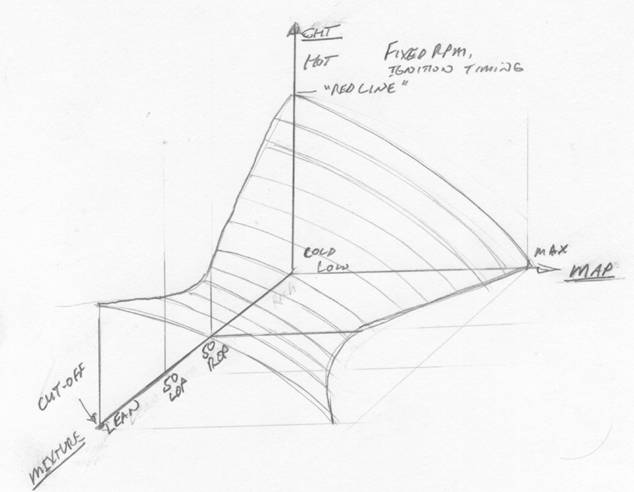>> This forum is best when it is useful
and helpful. While there have been many helpful
contributions to this thread, the one above is not one of them. <<
Sorry I didn't meet your expectations. I
will try to do better.
I ask George:
qualitatively is this about right? If not, help us understand what the
real envelope looks like, or let us know if this is a faulty
concept.

The envelope is
useful. However, as you point out:
>>
Note that a given envelope is also
defined by the octane rating of the fuel, RPM, ignition timing, and spark plug
heat range ...<<
And I would add to that, INDUCTION AIR
TEMPERATURE. That one is OFTEN badly overlooked and it is a major
driver WRT detonation.
>> Hot plugs will lead
to detonation at richer mixtures or lower manifold pressure or cooler cylinder
head temperatures. <<
Well... not really. Hot plugs are almost
exclusively a pre-ignition issue, not a detoantion issue. But
then pre-ignition is a much uglier thing than
detoantion.
>> Certified aircraft have
to operate within a broadly defined envelope because the regulators say it must
be so.
However, careful operators don’t go
out to the corners of the envelope. They run cooler, or richer (or leaner)
or with lower manifold pressure, and with ignition timing and such within well
defined limits while using the right fuel. <<
The problem is that I have NEVER seen an experimental
aircraft that had properly defined that "smaller envelope" with appropriate
markings and limitations on the instrument panel.
>> Those that push MAP,
mixture, and temperature outside the smaller envelope created by hotter plugs or
improper timing end up with broken engines. <<
But WHERE are the boundaries of that envelope
???
>> So while Randy may see
trouble with broken engine parts and attribute them to the automotive spark
plugs, I suggest it may be more accurate to say that it is likely that a
particular engine was operated out of its safe operating envelope and
could not handle it. This envelope may well be smaller if one uses
automotive spark plugs. I don’t know. <<
And, with all effort at trying to say this in a low
key manner - - not only do you not know - - but I don't know.
And if I don't know, I am rather certain that very few of the folks
operating their experimental aircraft engines know the answer - - and thus they
continue to operate with the "hope" (not a method) that they
will be "OK".
>> And I suggest that
Grayhawk and others who have experienced no difficulty with automotive spark
plugs have enjoyed no problems because their practices keep them well within
their operating envelope all the time, even if they do not know what the limits
of the envelope may be. And it may well be smaller than with aircraft
spark plugs.
George, does this sound
reasonable? <<
It is reasonable only in the context of two further
constraints: - - the owners really do want to be "experimental test
pilots" and they are comfortable with hoping that they have fully explored
the relevant envelope.
>> Full disclosure: I am
keenly interested to learn more, particularly since I am running an IO-550 with
10:1 pistons, one mag, and one electronic ignition with automotive spark plugs
in the top plug holes. Why? Because Down Under avgas is
US$6.30 a gallon, so 55-60% power LOP is a way of life. I like CHT’s below
320F in the climb, and frequently see under 300F LOP. That is how I try to
stay inside my envelope. If there is a better way, I would like to learn
about it. <<
Two questions:
1) What benefit to you think you get from the 10:1 CR
?
2) Have you marked your CHT with a redline at some
number below 460 d F?
Regards, George